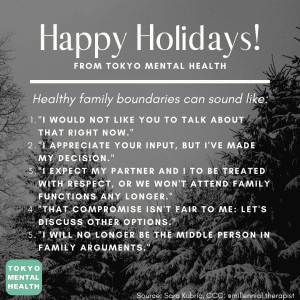Skylar Hom
The winter holiday is one of the most anticipated times of the year, and with good reason. It is a time when we get to relax and enjoy the holiday festivities. Most significantly, it is also a time where families tend to reconnect with one another.
While meeting with family is usually a happy event, it is not without its faults. In actuality, the holiday season can be a very stressful time for families. Establishing healthy family boundaries can be one of the best ways to help your holidays run smoothly, as well as setting up the foundation for well-functioning relationships that will enrich your life.
What are personal boundaries?
Personal boundaries are the rules and limits we make in our interpersonal relationships. They are important for two reasons. Firstly, they are essential when maintaining healthy relationships. A relationship that functions on reciprocal agreement and good communication becomes stronger over time. Boundaries are also important for self-preservation. While humans are social creatures, we are not wholly altruistic. Relationships are chiefly important aspects of our lives; but as with all things, they require mental and physical energy. When our relationships are in discord, it makes all other elements of our life seem difficult. The mental toll that our interpersonal lives can have on our wellbeing can be drastic. As such, healthy boundary setting is helpful for mental health.
Boundaries help establish balance in our lives. They lead not only to inner peace, but also to more meaningful relationships.
What do boundaries often look like?
In all our relationships, we have some sort of pre-established boundaries, whether wittingly or not. While well-intentioned, boundaries can sometimes become unhealthy. There are three types of boundaries. It might be easiest to imagine them on a scale.
Rigid
Rigid boundaries are chiefly intimacy-avoidant. These boundaries are usually isolationist — having an overwhelming tendency to say “no” may result in these relationship dynamics. Rigid boundaries cause distant relationships.
Porous
Porous boundaries are the opposite of rigid boundaries. They are intimacy-dependent. Individuals with porous boundaries may often overshare personal information and become too involved in the issues of others. They also often cannot say “no”. This causes mental exhaustion, and is bad for one’s well being.
Healthy
Healthy boundaries exist between rigid and porous boundaries. They foster relationships where both individual’s opinions are valued. The primary characteristic of healthy boundaries is the communication and understanding of one another’s feelings and expectations. It is also the ability to say and accept “no”. Healthy boundaries maintain sympathy for the other person without compromising one’s own values.
Why are boundaries so important for the holidays?
The holiday season is a time when many people visit their families. For the international community of Japan, this may mean returning to your home country to reunite with family who you have not seen in many months or years. This anxiety, coupled with the stress of the holiday season, can cause mental strain.
There is also the consideration of cultural differences. Japan will naturally have different definitions of healthy and unhealthy boundaries than what you are familiar with in your home country. Boundaries are extremely important when forming relations with people who have drastically different life and cultural experiences compared to your own.
How can healthy boundaries be established?
Firstly, the following are examples of ways to set up healthy boundaries:
“I appreciate your concern, but this is my decision.”
“I understand you are frustrated, but I don’t want to participate in family arguments.”
“I respect your values and beliefs, but I do not share them.”
“I expect my partner and I to be treated with respect, or we won’t come over anymore.”
Sara Kubric. Examples of healthy ways to communicate boundaries
A boundary is set up through communication. Even one sentence can be the catalyst to form healthy boundaries. The boundary should also be followed by a strict adherence to it: if a rule is agreed upon but not followed, then it paves the way for further unhealthy boundaries.
One common misconception about boundaries is that they are always made by saying “no”. This is not quite true; boundaries are not only made by putting your foot down. Establishing interpersonal limits are an important aspect of healthy boundaries.
For example, a person with porous boundaries may have a habit of sharing too much personal information. However, establishing a rule where sharing anything about themself is not allowed simply does not work. In this case, middle ground must be reached. One compromise could be for that person to first seek an emotional outlet that is not the other person. Perhaps they have a journal that they would write their feelings in before seeking counsel from the other person.
A boundary is set up through communication…. One common misconception about boundaries is that they are always made by saying “no”.
While establishing healthy boundaries may seem like a balancing act, they are started with a simple sentence. Candid and honest communication about one’s own desires and expectations, without compromising one’s values, will promote healthy relationships now and in the future.
Sources:
“Family Boundaries Can Sound Like” infographic (Sara Kubric, @millennial.therapist)
https://uhs.berkeley.edu/sites/default/files/relationships_personal_boundaries.pdf
